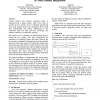478 search results - page 12 / 96 » Working Effectively with Legacy Code |
HOTOS
2007
IEEE
13 years 11 months ago
2007
IEEE
We propose a new concurrent programming model, Automatic Mutual Exclusion (AME). In contrast to lock-based programming, and to other programming models built over software transac...
CVPR
2012
IEEE
11 years 9 months ago
2012
IEEE
In this paper, we propose a bilevel sparse coding model for coupled feature spaces, where we aim to learn dictionaries for sparse modeling in both spaces while enforcing some desi...
281
click to vote
Lecture Notes
I have been designing and building applications, including the databases used by those applications, for several decades now. I have seen similar problems approached by different d...
OOPSLA
2007
Springer
14 years 1 months ago
2007
Springer
Custom House's new currency exchange system is integrated with a legacy system. After a few years of growth, the two systems were so intricately tangled that even small chang...
JSS
2000
13 years 7 months ago
2000
This paper presents the results of a study where the effects of introducing code reviews in an organisational unit have been evaluated. The study was performed in an ongoing comme...

